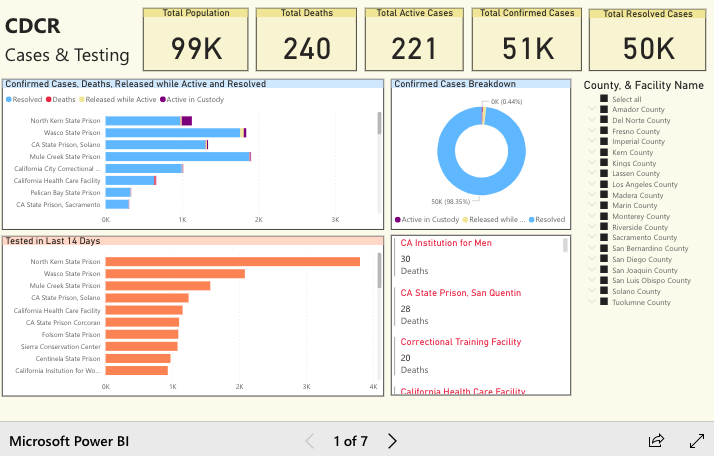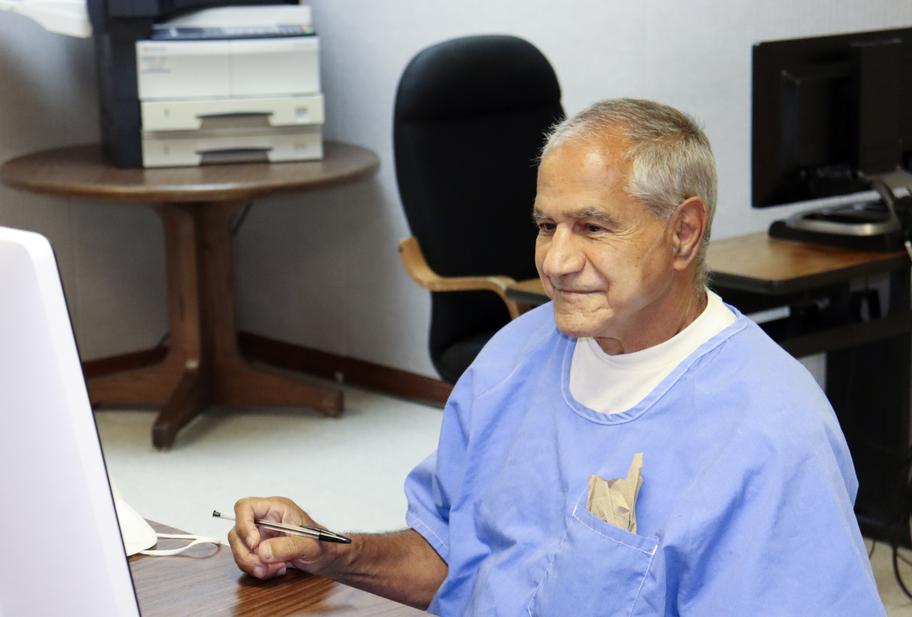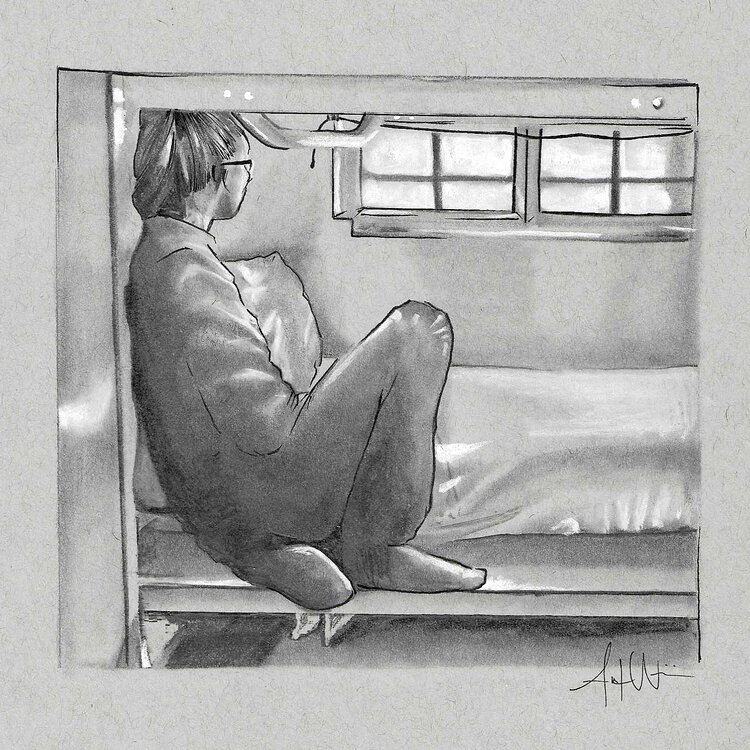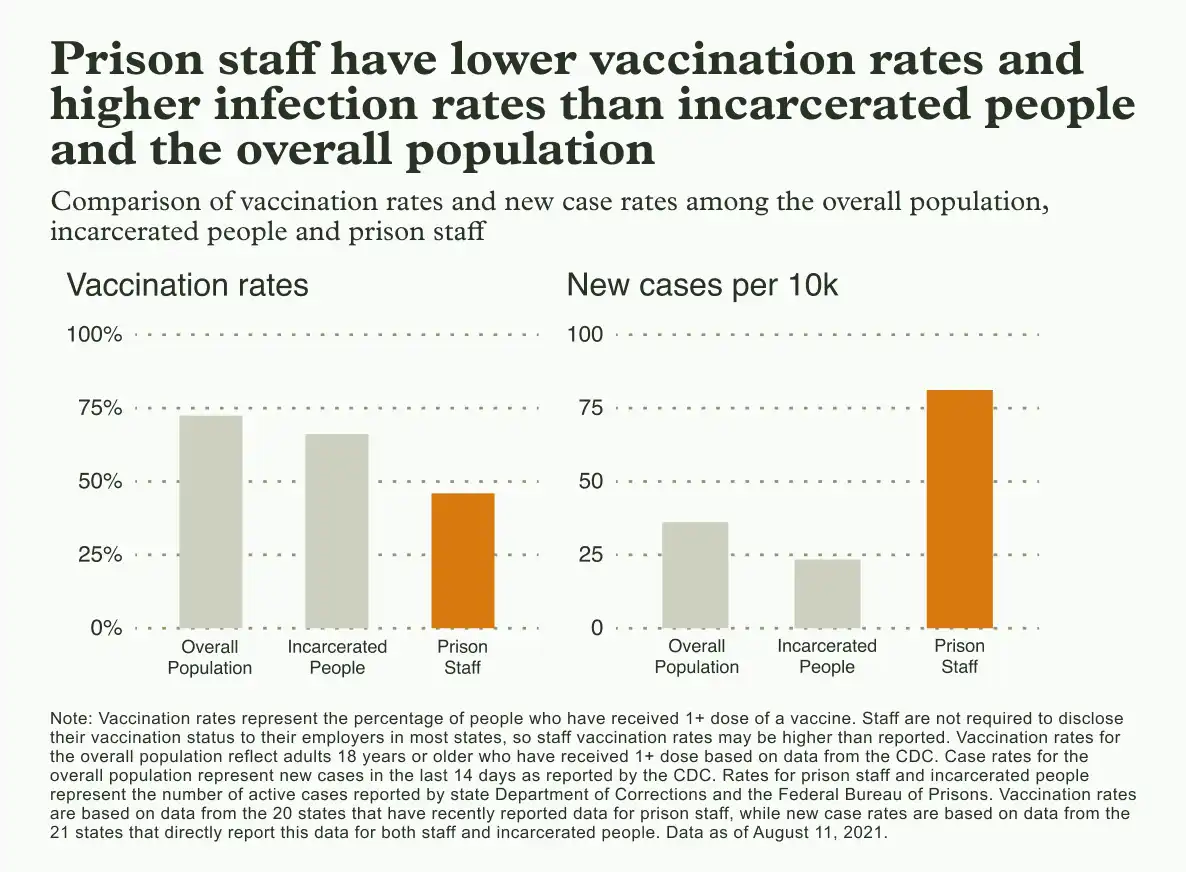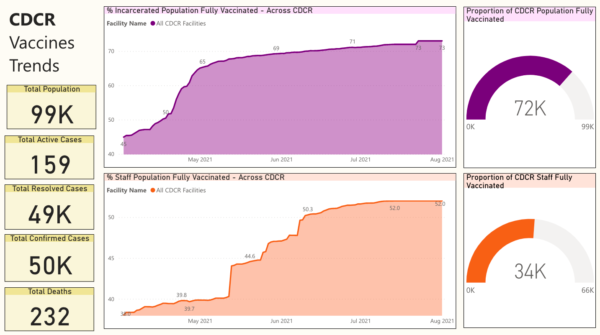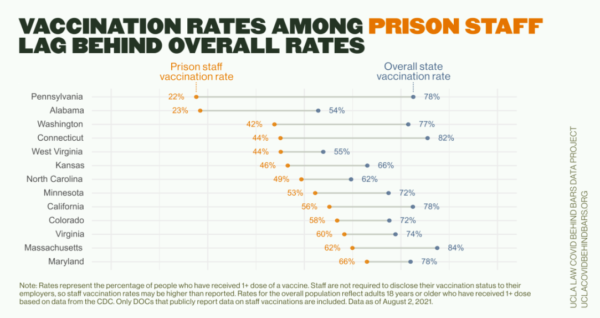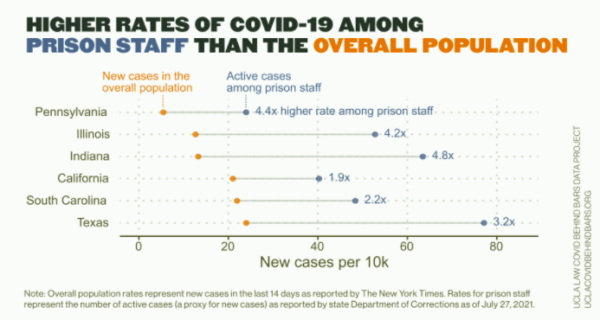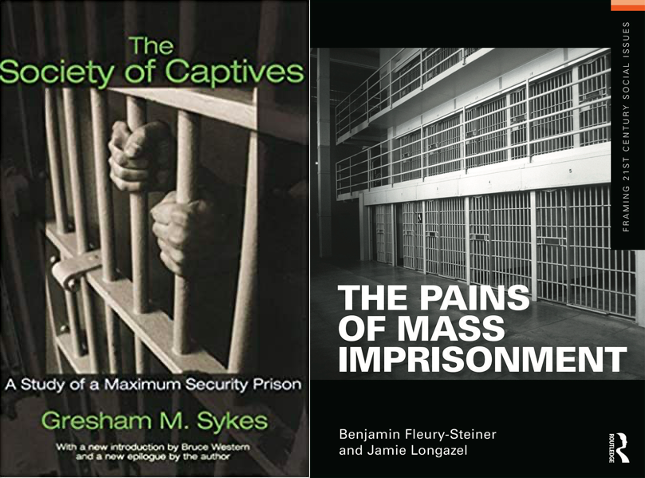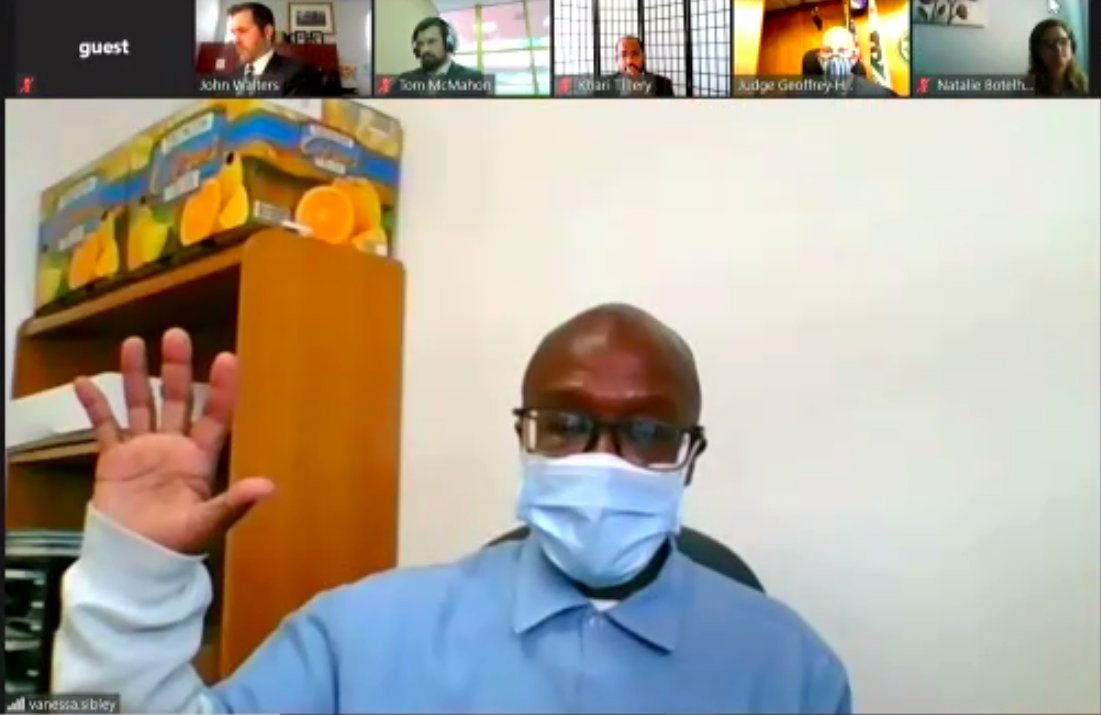This week has seen several important developments in the legal cases associated with COVID-19 in prisons, the most recent of which is a tentative ruling (subject to objections from the parties, of which there are expected to be many) from Judge Howard of the Marin Superior Court in Hall (Von Staich), the case examining the San Quentin COVID tragedy. Here is Judge Howard’s 114-page ruling:
Final Tentative Ruling 10-15-21_AC (1) by hadaraviram on Scribd
The ruling provides a comprehensive historical narrative of the outbreak at San Quentin, starting with the fateful transfer from CIM, and complete with the testimonies of incarcerated and expert witnesses. Judge Howard discusses the ineptitude and mismanagement at San Quentin, from the Warden to the custodial and medical staff; he relays the many rejected offers for help. Notably, when discussing the impact on incarcerated people, the opinion takes special care of relaying the impact of the crisis on mental health and morale (through the testimony of Dr. Kupers and several incarcerated witnesses.) Also to Judge Howard’s credit, he discusses the ancillary punitive aspects of the prison’s response to COVID, which amounted to solitary confinement for many long months.
While the decision commends CDCR for some of what they did, ultimately it relies on evidence from both petitioners and respondent to show that, had they done nothing, the rate of infection, disease, and death would have been the same.
The upshot, though, is that Judge Howard denies relief to petitioners due to mootness:
[T]he vaccine changed the game for COVID-19 at San Quentin. With a nearly 80 percent inmate vaccination rate, COVID-19 has all but disappeared from inside the prison. Although COVID-19 remains a risk within San Quentin, it appears at present no more tha, and perhaps even less than, the risk faced by the community at large.
But even if COVID-19 continues to pose a substantial risk of serious harm, the combination of substantial population reduction, mitigation measures, and most importantly vaccine rollout, to every inmate in the prison shows that Respondent does not “knowingly and unreasonably” disregard an objectively intolerable risk of harm. By offering the vaccine to all inmates, Respondent has responded reasonably and effectively with the best tool available to mitigate the harm. This situation differs from the scenario presented to the In re Von Staich court, where “Absent a vaccine or an effective treatment, the best way to slow and prevent spread of the virus is through social or physical distancing, which involves avoiding human contact, and staying at least six feet away from others.” Here, the vaccine, combined with other measures, allows less physical distance. Petitioners did not carry their burden to show that Respondent continues to unreasonably disregard a known serious risk by failing to take further measures such as further reducing the prison population.
But Judge Howard doesn’t end there. He explains that, even when relief is denied due to mootness, where “a question of general public interest which is likely to recur,” habeas petitioners may seek a declaration of rights in these circumstances, “including where the court may have difficulty ruling on the issue while the controversy is alive, and where it presents important issues of liberty and social interest.” This, he says, is just such an issue. And so, the last five pages of the decision lambast CDCR/CCHCS in general, and San Quentin officials in particular, for their ongoing neglect and for the general conditions of the prison, which are conducive to future contagion. Here is Judge Howard’s declaration:
- Respondent caused “the worst epidemiological disaster in California correctional history.” [my emphasis – H.A.] In doing so, Respondent recklessly ignored what it knew then and concedes now – that COVID-19 posed a “substantial risk of serious harm to the health and safety of petitioners.”
- Respondent’s conduct that resulted in 75 percent of the San Quentin inmates contracting COVID-19, and 28 deaths, implicates “matters of clear statewide importance” relating to the “efficacy of the measures officials have already taken to abate the risk of serious harm to petitioner and other prisoners, as well as the appropriate health and safety measures they should take in light of present conditions.” (Staich on H.C., supra, 272 Cal.Rptr.3d 813.)
- During the 2020 COVID-19 outbreak at San Quentin, Respondent violated Petitioners’ rights under the Eighth Amendment to the United States Constitution and article I, section 17 of the California Constitution to be free of cruel and unusual punishment. Respondent exhibited deliberate indifference to the admitted risk posed by COVID-19, by (a) violating its own rules and procedures when it transferred the CIM inmates to San Quentin, knowing that those inmates posed a risk of introducing COVID-19 into San Quentin; (b) violating its own rules and procedures during the intake and processing of the newly-arrived CIM inmates, in particular by ignoring obvious COVID-19 symptoms, failing to quarantine the transferees, failing adequately to screen them, and failing to test them until after they had already begun to infect the existing San Quentin population; (c) ignoring advice from its own medical professionals and CDC guidance by failing to provide adequate PPE, mixing sick and well inmates, failing to cohort inmates adequately, failing to enforce social distancing, and failing to provide adequate or timely testing; and (d) ignoring Willis/MDPH’s recommendations without any basis other than that MDPH purportedly had no authority over Respondent.
- As in Plata, “[n]umerous experts testified that crowding is the primary cause of the constitutional violations.” (Brown v. Plata, supra, 563 U.S. at p. 521.) The evidence shows that compliance with the Urgent Memo’s population reduction recommendation in a timely fashion substantially would have reduced the scope and severity of the COVID-19 outbreak at San Quentin. Respondent knew about the Urgent Memo. It further knew that population reduction could effectively combat viral spread (as evidenced by its own population reduction efforts). Respondent failed to comply with the Urgent Memo recommendation or engage any expert of its own. Without adequate investigation or the benefit of any alternative expert opinion, ignoring the Urgent Memo’s population reduction recommendation constituted further deliberate indifference. Indeed, Respondent had the means at its disposal quickly to comply with the Urgent Memo’s recommendation; instead, it chose to litigate the matter while people died. Respondent has offered no valid argument why it could not have complied with the Urgent Memo’s recommendation. In Plata, in addition to the criteria imposed by the PLRA, the state had to consider an order involving the entire California prison system. The state could not comply with that order simply by moving inmates. It had to either release them or build more space. Here, by contrast, the problem involves only one, antiquated prison, with architectural characteristics not shared by many other prisons in the state system. Respondent contends it would violate “contemporary standards of decency” to release Petitioners prior to the end of their sentences. (Respondent Opp. at pp. 23, 57.) But it could have reduced the population through means other than outright release. Indeed, the remedy ordered by the Court of Appeal in the October 2020 In re Von Staich Order did not necessarily involve releasing any inmates. (In re Von Staich, supra, 56 Cal.App.5th at p. 84 [“To be clear: We do not order the release of petitioner or any other inmate”], emphasis in original.) Instead, the Court of Appeal left to Respondent the most efficient and effective means of reducing the population, considering the variety of factors prison officials must consider. (Ibid.) While release is certainly one option to reduce the population at San Quentin, prison officials had several other options available to them. For example, they could have transferred inmates to a different prison (following all safety protocols). The failure to do so, or at least to make good faith efforts to do so, unreasonably exposed inmates, staff, and the surrounding community to a substantial risk of serious harm.
- The failure to reduce the population resulted in other constitutional deprivations of liberty. Because Respondent did not reduce the population as recommended, it effectively consigned hundreds of inmates to unwarranted, unnecessary, solitary confinement. And not just for a day or two. Where Respondent had the ability to move inmates to other facilities or release them, the court can conceive of no argument to support forcing inmates to remain in a cell smaller than 50 square feet, with two bunks, and a cellmate, for virtually 24 hours a day, seven days a week, for months on end. Doing so enhanced the inmates’ exposure to COVID-19. For the duration it lasted, it also amounted to solitary confinement in violation of common standards of decency, with all the physical and mental health effects that result. (6 RT 1206-07.) (See Exhibits 370.011 and 370.012, depicting the solitary confinement cells during lockdown in the “Blocks” at Sec. IV.B.1.a, supra.) Respondent knows about these effects. Its mental health team prepared for them, reported them, and treated them. Simply put, confinement for that long, with another person, in a space so small and foul, implicates “nothing less than the dignity of” humans. (Trop v Dulles, supra, 356 U.S. at pp. 100-101.)
- Isolating COVID-positive inmates in the AC contributed to the spread of COVID-19 because inmates fear the AC. Using the AC as an isolation unit disincentivizes candid reporting of symptoms, an essential component of any effective COVID-19 mitigation strategy.
Respondent contends population reduction “involves significant policy questions about public safety and criminal justice” best left to other branches of government. (Resp. Opp. at p. 42.) However, if Respondent insists on continuing to operate an obsolete and dangerous prison that, whenever an airborne pathogen arises, threatens the health and safety of the prison population, not to mention the surrounding community, then Respondent will leave the courts with no choice but to intervene. Moreover, the circular notion that “the operation of our correctional facilities is peculiarly within the province of the Legislative and Executive Branches of Government, not the Judicial” (Bell v. Wolfish (1979) 441 U.S. 520, 548), relied upon by Respondent, assumes the lack of a constitutional violation.
No one knows how COVID-19 will behave in the future. No one knows what effect
Respondent’s efforts to vaccinate the entire inmate population will have in combating any future
outbreak. Petitioners have not – at this time – carried their burden to show current deliberate
indifference warranting injunctive relief. However, the record raises serious questions about
whether Respondent has learned the right lessons from the 2020 COVID-19 debacle at San
Quentin. It continues to operate a prison uniquely situated to allow the spread of any airborne
pathogen, including COVID-19, in a manner seemingly indifferent to the specific characteristics
that resulted in such extensive illness and death just last year. For example, Respondent
continues to double cell prisoners in multi-tiered units with open barred doors, a living
environment that enhances the risk of disease transmission. Respondent also appears intent on relying on the same population spread – as opposed to population reduction – strategy it
employed in 2020. It plans to lockdown double-celled inmates, when necessary to quarantine
them, in the cells measuring 49 square feet that make up the tiered housing units. Depending on
the circumstances, including the severity of any future outbreak, the findings above should cast
significant doubt on the wisdom of those strategies.
***
In the meantime, there have been developments with other cases. On the heels of Judge Tigar’s order to mandate vaccination for prison guards, CDCR published a three-page plan for implementation, which excludes many people from the need to get vaccinated–while at the same time filing a notice of appeal the mandate. This is indefensible, coming from the administration that bills itself as pro-science and pro-vaccine. Simultaneously, a Kern County Superior Judge blocked the vaccine mandate order for Kern County correctional officers – unfathomably, just as North Kern State Prison is seeing a serious outbreak:
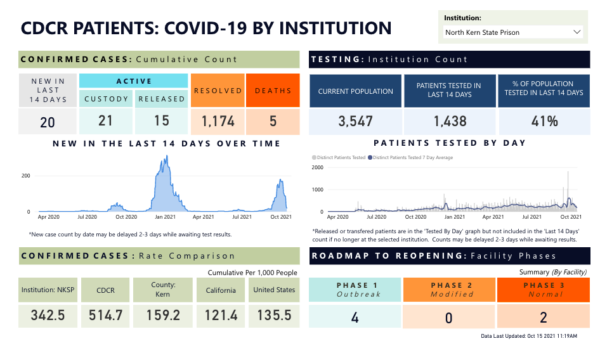
Judge Barmann explained his decision: “What I don’t want to do is I don’t want to put somebody in a situation where there’s something that happens to them that truly is irremediable.” As I said on the radio, this language can act as a dog whistle to COVID deniers, because guess what, long-term COVID and death are what’s “irremediable.”
Stay tuned for more developments in all these cases.


